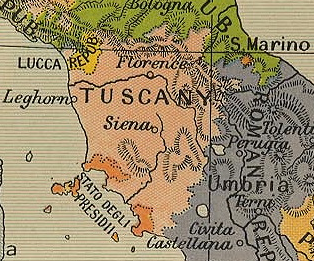|
Orbetello
Orbetello is a town and ''comune'' in the province of Grosseto (Tuscany), Italy. It is located about south of Grosseto, on the eponymous lagoon, which is home to an important Natural Reserve. History Orbetello was an ancient Etruscan settlement, which in 280 BC passed under the control of the Romans, who had founded their colony of Cosa (near the modern Ansedonia). The emperor Domitian had a substantial property here, which had belonged to the Domitii Ahenobarbi and he inherited through his wife Domitia Longina. He also built other sumptuous villas nearby for his courtiers. In the Middle Ages it was a possession of the Aldobrandeschi family, who held it until the 14th century, when it was acquired by the city of Orvieto. After several struggles with the Orsini of Pitigliano and Orvieto, in the following centuries Orbetello was captured by the Sienese Republic. In the mid-16th century it was part of the State of Presides, a Spanish possession, becoming its capital. The town ... [...More Info...] [...Related Items...] OR: [Wikipedia] [Google] [Baidu] |
Battle Of Orbetello
The Battle of Orbetello, also known as the Battle of Isola del Giglio, was a major naval engagement of the Franco-Spanish War of 1635. It was fought on 14 June 1646 off the Spanish-ruled town of Orbetello, on the coast of Tuscany, Italy, between a French fleet led by Admiral Armand de Maillé, Marquis of Brézé, and a Spanish fleet commanded by Miguel de Noronha, 4th Count of Linhares sent to break the blockade of Orbetello and relieve the town, besieged since 12 May by a French army under the command of Prince Thomas of Savoy. The Battle of Orbetello was tactically very unusual, since it was fought by sailing ships towed by galleys in a light breeze. After a hard but inconclusive fight during which Admiral Brézé was killed, the French fleet withdrew to Toulon leaving the sea to the Spanish, who decided not to pursue them to relieve Orbetello. The land forces disembarked by Count of Linhares a few days later, however, failed to dislodge the French lines, and the siege could ... [...More Info...] [...Related Items...] OR: [Wikipedia] [Google] [Baidu] |
Cosa
Cosa was a Latin colony founded in southwestern Tuscany in 273 BC, on land confiscated from the Etruscans, to solidify the control of the Romans and offer the Republic a protected port. The Etruscan site (called ''Cusi'' or ''Cosia'') may have been where modern Orbetello stands; a fortification wall in polygonal masonry at Orbetello's lagoon may be in phase with the walls of Cosa. The position of Cosa is distinct, rising some 113 metres above sea level and is sited 140 km northwest of Rome on the Tyrrhenian Sea coast, on a hill near the small town of Ansedonia. The town experienced a hard life and was never truly a prosperous Roman city, although it has assumed a position of prominence in Roman archaeology owing to the circumstances of its excavation (cf. Dyson 2005, below). After the foundation, wars of the 3rd century BC affected the town. New colonists arrived in 197 BC. Cosa seems to have prospered until it was sacked in the 60s BC, perhaps by pirates - although an ea ... [...More Info...] [...Related Items...] OR: [Wikipedia] [Google] [Baidu] |
Albinia
Albinia is a town in Tuscany, central Italy, administratively a frazione of the comune of Orbetello, province of Grosseto, in the Tuscan Maremma. At the time of the 2001 census its population amounted to . and it is the most populous in Orbetello municipality. Albinia is easily reached from |
Stato Dei Presidi
The State of the ''Presidi'' ( it, Stato dei Presidi,. In french: État des Présides. Dhondt uses "Tuscan ''presidia''". meaning "state of the garrisons") was a small territory in Italy between 1557 and 1801. It consisted of the remnants of the former Republic of Siena, five towns on the Tuscan coast—Porto Ercole and Porto Santo Stefano on the promontory of Monte Argentario, as well as Orbetello, Talamone and Ansedonia—and their hinterland, along with the islet of Giannutri and the fortress of Porto Longone on the island of Elba. The ''Presidi'' encompassed about 300 km2. They were effectively attached to the Kingdom of Naples and changed hands several times with it, resulting in three distinct historical periods. From 1557 to 1707, they were a possession of the Crown of Spain administered by the Spanish Habsburg viceroy of Naples; from 1708 to 1733, a possession of the Austrian Habsburgs administered by their viceroy in Naples; and from 1733 to 1801, a dependency of the ... [...More Info...] [...Related Items...] OR: [Wikipedia] [Google] [Baidu] |
Talamone
Talamone is a town in Tuscany, on the west coast of central Italy, administratively a frazione of the comune of Orbetello, province of Grosseto, in the Tuscan Maremma. Talamone is easily reached from Via Aurelia, and is about from Grosseto and from Orbetello. Geography The village lies on a rocky promontory, which lies on the southern border of the Maremma nature reserve, in a dominant position along the whole stretch of coast arriving at Mount Argentario. The surrounding area is characterized by the presence of vegetation typical of Mediterranean scrub and long sandy beaches, lined by pine trees. History An ancient and flourishing city already during the Etruscan period, which saw a decisive battle in 225 BC between Roman and the Celtic armies who were heading for Rome. Talamone was razed to the ground by Sulla for the support that its citizens gave to Marius in his attempt to march against Rome after the return from his African exile. Like Orbetello, the late Middle ... [...More Info...] [...Related Items...] OR: [Wikipedia] [Google] [Baidu] |
Fonteblanda
Fonteblanda is a village in Tuscany, central Italy, administratively a frazione of the comune of Orbetello, province of Grosseto, in the Tuscan Maremma. At the time of the 2001 census its population amounted to 904. . Fonteblanda is easily reached from , and is about 25 km from |
Ansedonia
Ansedonia is a ''frazione'' of the ''comune'' of Orbetello, in the province of Grosseto, southern Tuscany (Italy). At the time of the 2001 census, its population was 88. National Institute of Statistics (Italy), Istat. It is a renowned tourist resort. The village lies near the ruins of the ancient Roman town of Cosa. See also * Albinia * Fonteblanda * Giannella * San Donato, Orbetello * TalamoneReferences External links * Frazioni of Orbetello Coastal towns in Tuscany {{Grosseto-geo-stub ...[...More Info...] [...Related Items...] OR: [Wikipedia] [Google] [Baidu] |
Giannella
Giannella is a village in Tuscany, central Italy, administratively a frazione of the comune of Orbetello, province of Grosseto, in the Tuscan Maremma. At the time of the 2001 census its population amounted to 160. . Geography The hamlet of Giannella is located along the strip of land ('''') which connects the mainland with the promontory of ...[...More Info...] [...Related Items...] OR: [Wikipedia] [Google] [Baidu] |
San Donato, Orbetello
San Donato is a village in Tuscany, central Italy, administratively a frazione of the comune of Orbetello, province of Grosseto, in the Tuscan Maremma. At the time of the 2011 census its population amounted to 18. San Donato is about 30 km from Grosseto and 15 km from Orbetello. The village was founded in the late 1950s as a result of the ''riforma fondiaria'' (land reform) in Maremma. It is divided into the hamlets of ''San Donato Centro'' and ''San Donato Vecchio''. It is known for the ''Sagra della Panzanella'', a festival held every summer since 1999 to celebrate the Tuscan dish panzanella. Main sights * ''San Donato'', main parish church in the village, it was designed by engineer Ernesto Ganelli and consecrated in 1961. * Etruscan archaeological sites of San Donato Centro, San Giovanni, Volta di Rote and Doganella. Bibliography * * * See also * Albinia * Ansedonia * Fonteblanda * Giannella * Talamone Talamone is a town in Tuscany, on the west coast of ... [...More Info...] [...Related Items...] OR: [Wikipedia] [Google] [Baidu] |
Province Of Grosseto
The province of Grosseto ( it, links=no, provincia di Grosseto) is a province in the Tuscany region of Italy. Its capital is the city of Grosseto. As of 2013 the province had a total population of 225,098 people. Geography The Province of Grosseto completely occupies the southern end of Tuscany, and with a territorial area of , it is the most extensive in the region and one of the least dense in population in Italy. The province is bordered to the northwest by the Province of Livorno, to the north by the Province of Pisa, to the northeast by the Province of Siena, and to the southeast by the Province of Viterbo in Lazio. To the south is the Tyrrhenian Sea, which includes the southern islands of the Tuscan archipelago, including Isola del Giglio and the smaller Giannutri islands and Formiche di Grosseto and Formica di Burano. The Arcipelago Toscano National Park spans both the provinces of Grosseto and Livorno, and includes the seven main islands of the Tuscan Archipelago: Elba ... [...More Info...] [...Related Items...] OR: [Wikipedia] [Google] [Baidu] |
Italo Balbo
Italo Balbo (6 June 1896 – 28 June 1940) was an Italian fascist politician and Blackshirts' leader who served as Italy's Marshal of the Air Force, Governor-General of Libya and Commander-in-Chief of Italian North Africa. Due to his young age, he was sometimes seen as a possible successor of dictator Benito Mussolini. After serving in World War I, Balbo became the leading Fascist organizer in his home region of Ferrara. He was one of the four principal architects (''Quadrumviri del Fascismo'') of the March on Rome that brought Mussolini and the Fascists to power in 1922, along with Michele Bianchi, Emilio De Bono and Cesare Maria De Vecchi. In 1926, he began the task of building the Italian Royal Air Force and took a leading role in popularizing aviation in Italy, and promoting Italian aviation to the world. In 1933, perhaps to relieve tensions surrounding him in Italy, he was given the government of Italian Libya, where he resided for the remainder of his life. Balbo, ... [...More Info...] [...Related Items...] OR: [Wikipedia] [Google] [Baidu] |
Province Of Grosseto
The province of Grosseto ( it, links=no, provincia di Grosseto) is a province in the Tuscany region of Italy. Its capital is the city of Grosseto. As of 2013 the province had a total population of 225,098 people. Geography The Province of Grosseto completely occupies the southern end of Tuscany, and with a territorial area of , it is the most extensive in the region and one of the least dense in population in Italy. The province is bordered to the northwest by the Province of Livorno, to the north by the Province of Pisa, to the northeast by the Province of Siena, and to the southeast by the Province of Viterbo in Lazio. To the south is the Tyrrhenian Sea, which includes the southern islands of the Tuscan archipelago, including Isola del Giglio and the smaller Giannutri islands and Formiche di Grosseto and Formica di Burano. The Arcipelago Toscano National Park spans both the provinces of Grosseto and Livorno, and includes the seven main islands of the Tuscan Archipelago: Elba ... [...More Info...] [...Related Items...] OR: [Wikipedia] [Google] [Baidu] |




